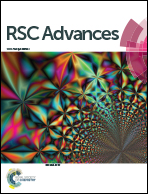Reductant- and stabilizer-free synthesis of graphene–polyaniline aqueous colloids for potential waterborne conductive coating application†
Abstract
The chemical reduction of graphene oxide (GO) typically involves highly toxic reducing agents which could contaminate and have a negative effect on the conductivity of the resulting materials. Herein we report a facile approach to prepare stable reduced graphene oxide (rGO) aqueous colloids using reduced polyaniline nanofiber (rPANI-NFs) as both a reducing and a stabilizing agent. The efficient reduction of GO is verified by infrared spectroscopy, Raman spectroscopy, X-ray diffraction and X-ray photoelectron spectroscopy. The adsorption of polyaniline nanofibers onto the rGO nanosheets allows a stable rGO aqueous dispersion to be formed through electrostatic stabilization. Since the rPANI-NFs could be easily doped and converted to a highly conductive material after reduction of GO, this approach provided a new method for large-scale production of aqueous rGO dispersions with great potential applications in environmentally friendly waterborne conductive coatings and construction of various graphene-based materials as demonstrated in this study of cellulose nanofiber–graphene composites.


 Please wait while we load your content...
Please wait while we load your content...